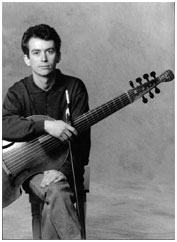Hantaï Brothers and Friends, Library of Congress
We welcome another review from Ionarts guest contributor Michael Lodico. The Hantaï Brothers and Friends offered patrons a pleasurable evening of duos by Mozart and trios by Haydn on the Library of Congress series Friday evening. The concert opened with the Trio in D Major for flute, violin, and cello, op. 38, no. 1, which gave the audience in the packed Coolidge Auditorium the opportunity to listen closely to the performers’ elegant and unforced playing. Placing two instruments of similar timbre together, Haydn allowed the violinist (Alessandro Moccia) to lead and be accompanied by the Baroque flutist (Marc Hantaï), while occasionally, and more interestingly allowing the quiet flute to lead and be gently accompanied by the violin. Instead of the audience’s attention being held by the performers’ virtuosity, they were able to relax in their seats to hear the form of each movement gradually unfold. This concert was about the music, not the performers.
The Hantaï Brothers and Friends offered patrons a pleasurable evening of duos by Mozart and trios by Haydn on the Library of Congress series Friday evening. The concert opened with the Trio in D Major for flute, violin, and cello, op. 38, no. 1, which gave the audience in the packed Coolidge Auditorium the opportunity to listen closely to the performers’ elegant and unforced playing. Placing two instruments of similar timbre together, Haydn allowed the violinist (Alessandro Moccia) to lead and be accompanied by the Baroque flutist (Marc Hantaï), while occasionally, and more interestingly allowing the quiet flute to lead and be gently accompanied by the violin. Instead of the audience’s attention being held by the performers’ virtuosity, they were able to relax in their seats to hear the form of each movement gradually unfold. This concert was about the music, not the performers.
Mozart’s Sonata in G Major for violin and piano, K. 379, featured Moccia accompanied by Jérôme Hantaï on the fortepiano. The fortepiano used was surprisingly not from one of the 20 million musical pieces in the Library of Congress’s possession, but borrowed, since a fortepiano is apparently not among them. The instrument used was a copy of a German fortepiano after Jean-Louis Dulcken, circa 1788, crafted by Thomas and Barbara Wolf of Virginia in 1991. In addition to the beauty of the instrument’s rich veneer and grain patterns, it displayed a clear sound, pearly, and on a much softer scale than a modern piano.
The Mozart sonata was played with a great deal of care. The tempo taken in the opening Adagio allowed space for the performers to shape the musical figures in the utmost detail. In the delightful Andantino cantabile con variazioni, the phrase endings were at times so wonderfully delicate that the audience had to imagine them, partially. This nuance is possible due to the fortepiano’s capability of playing very softly while sustaining less.
Tom Huizenga, Two Brothers, Two Composers And Pretty Much One Sound (Washington Post, February 26) |
According to their biographies, these two of the three Hantaï brothers – harpsichordist Pierre was missing from Friday’s performance – gained much of their training and experience in Belgium from another musical family, the famed Kuijken brothers: baroque flutist Barthold; violinist and conductor Sigiswald; and viola da gamba player Wieland. Hopefully the full Hantaï Trio will be invited to perform in the Washington area soon.





















































1 comment:
Roland Celette, French Cultural Attache and Director of La Maison Francaise, mentioned to me Friday that he hoped to bring Pierre Hantaï to Washington next season to perform a harpsichord recital based upon Pierre's most recent recording(s). Perhaps ionarts.org can interest sponsors in hosting the full Hantaï trio of brothers.
Post a Comment